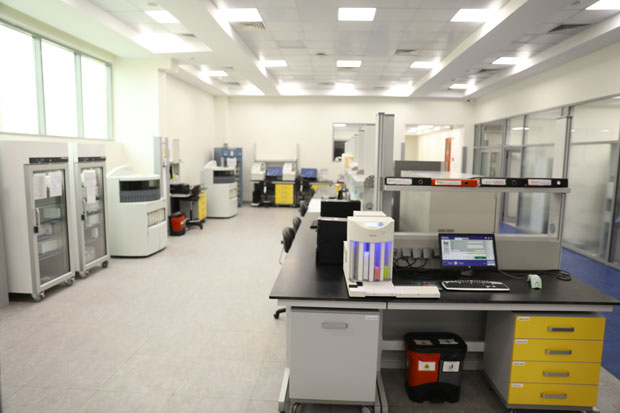BRAF V600E mutation

BRAFV600E mutation analysis
- Clinical Implications
- CNS Tumors
- BRAF mutation is reported in 33% of midline tumors, and has the highest incidence (66%) in pleomorphic xanthoastrocytomas.
- BRAF V600E mutation in pediatric Low Grade Gliomas decreases 10-year progression-free survival rate almost 40%, however, the use of BRAF inhibitors have shown a successful response.
- Melanoma
- BRAF mutation is the most common oncogenic driver in melanoma (~ 60%)
- Many BRAF fusions contribute to different responses to MAPK inhibition
- BRAF inhibitors
- Small molecule that binds mutated BRAF and renders protein inactivation
- FDA-approved inhibitors: Vemurafenib, dabrafenib, trametinib
- Colorectal Carcinoma
- BRAF mutations 6-15%
- Sporadic CRC with microsatellite instability high (MSI-H) vs. hereditary nonpolyposis colorectal carcinoma (HNPCC)
- Majority of sporadic CRCs with MSI-H have BRAF mutation
- HNPCC almost never has BRAF mutation
- Testing BRAF V600E status can avoid expense of full gene sequencing for mismatch repair genes
- Resistance to EGFR-targeted therapy by cetuximab and panitumumab is common in CRC with BRAF mutations
- BRAF mutation in non-MSI-H CRC is unfavorable prognostic marker
- Papillary Thyroid Carcinoma
- ~ 69% have V600E mutation
- V600E occurs mainly in classic variant & rare in other variants
- V600E is virtually absent in follicular, Hurthle cell, medullary thyroid carcinomas, and in benign thyroid tumors
- Recurrence, lymph node metastases, extrathyroidal extension, and advanced stage is common in tumors with V600E
- Non-Small Cell Lung Cancer
- Langerhans Cell Histiocytosis
- BRAF V600E is found in ~ 60% of patients
- Increased risk of initial treatment failure in patients with this mutation
- Associated with 2x increased risk for recurrence or relapse
- Test Description
- Test approach
- Reporting name
- Test prerequisites (To ensure timely results)
- Patient’s demographic data.
- Clinicopathologic information
- Pathology report (final or preliminary) including anatomic location.
- History of any given therapy for cancer and its date and relation to sample sent for molecular study (i.e. pre & post therapy). Therapy includes chemo and radiotherapy, hormonal or targeted therapy.
- Any other relevant clinical data or history.
- Type of sample:
- Preferred: Formalin-fixed, paraffin-embedded (FFPE) tumor tissue block.
- Acceptable:
- Section in Eppendorf: Up to 4 sections, each with a thickness of up to 10 μm and a surface area of up to 250 mm2 + good H&E slide for assessment.
- Five unstained slides + one good H&E slide.
- Specimen Minimum Volume: Two 10-micron sections of FFPE.
- Quality Control measures
- From your side:
- Double check you are fulfilling all required data before sending your sample.
- Check that your pathologist has selected the best block in terms of tumor cellularity, with least presence of necrosis and inflammation.
- Pretherapy sample is preferred (if underwent any cancer therapy).
- In our lab:
- Assessment of tissue for adequacy & tumor cellularity before any molecular analysis.
- Matching block ID with the report ID and demographic data.
- Matching the submitted block with the data reported in the pathology report.
- N.B
- If the sample sent in Eppendorf, it is your pathology lab’s responsibility to ensure the sample in Eppendorf is corresponding to the submitted H&E slide (we can’t prepare slide from Eppendorf).
- This test does not include a pathology consultation.
- Test Time
- Retention of the sample
- Selected References
- Turner JA et al: BRAF fusions identified in melanomas have variable treatment responses and phenotypes. Oncogene. ePub, 2018
- Ross JS et al: The distribution of BRAF gene fusions in solid tumors and response to targeted therapy. Int J Cancer. 138(4):881-90, 2016
- Aramini JM et al: The RAS-binding domain of human BRAF protein serine/threonine kinase exhibits allosteric conformational changes upon binding HRAS. Structure. 23(8):1382-93, 2015
- Holderfield M et al: Targeting RAF kinases for cancer therapy: BRAF -mutated melanoma and beyond. Nat Rev Cancer. 14(7):455-67, 2014
- Colomba E et al: Detection of BRAF p.V600E mutations in melanomas: comparison of four methods argues for sequential use of immunohistochemistry and pyrosequencing. J Mol Diagn. 15(1):94-100, 2013
- Hamilton SR: BRAF mutation and microsatellite instability status in colonic and rectal carcinoma: context really does matter. J Natl Cancer Inst. 105(15):1075-7, 2013
- Bollag G et al: Vemurafenib: the first drug approved for BRAF -mutant cancer. Nat Rev Drug Discov. 11(11):873-86, 2012
- Chapman PB et al: Improved survival with vemurafenib in melanoma with BRAF V600E mutation. N Engl J Med. 364(26):2507-16, 2011
- Wan PT et al: Mechanism of activation of the RAF-ERK signaling pathway by oncogenic mutations of B-RAF. Cell. 116(6):855-67, 2004
- Davies H et al: Mutations of the BRAF gene in human cancer. Nature. 417(6892):949-54, 2002
- García-Romero N, et al, BRAF V600E Detection in Liquid Biopsies from Pediatric Central Nervous System Tumors. Cancers. 2020.
BRAF V600E mutation is most common genetic alteration
BRAF mutations are mutually exclusive with KRAS and EGFR mutations
Real-time PCR for quantitative detection of BRAF v600E mutation
DNA was isolated and BRAF V600E mutation specific Competitive allele specific TaqMan assay along with its reference wildtype assay were performed. Results interpreted according to the manufacture user guide.
BRAF mutation
All samples are subject to stringent quality control measures that include:
From 3 days to 5 working days.
Client provided paraffin blocks & unstained slides (if provided) will be returned after testing is complete.